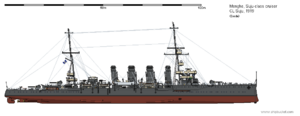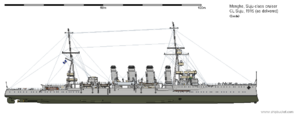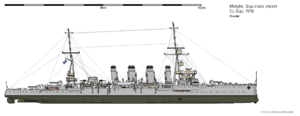Suju-class cruiser
 Suju as she appeared on combat deployment during the War of the Sienese Succession.
| |
| Class overview | |
|---|---|
| Builders: | Gothia |
| Operators: | Menghe |
| Succeeded by: | Janghŭng-class cruiser |
| Built: | 1912-1915 |
| In commission: | 1915-1933 |
| Planned: | 2 |
| Completed: | 2 |
| Lost: | 1 |
| Scrapped: | 1 |
| General characteristics Suju, 1918 | |
| Type: | Light cruiser |
| Displacement: |
|
| Length: | 129 m (423.2 ft) overall |
| Beam: | 12.4 m (40.6 ft) |
| Draft: | 4.17 m (13.7 ft) max |
| Propulsion: |
|
| Speed: | 27 knots |
| Range: | 2,300 nautical miles (4,300 km) at 12 knots |
| Complement: | 258 |
| Armament: |
|
| Armor: |
|
The Suju-class cruisers were a pair of protected cruisers built for the Menghean Navy in the 1910s. Constructed in Gothia using the latest propulsion technology, they were the first modern or fast light cruisers to be built in Menghe in the 1910s, designed to match contemporary foreign designs in their speed and protection. They were originally intended to serve as fleet scouts and counter-destroyer escorts along Menghe's east coast facing Dayashina, hence their relatively short range.
Both Suju and her sister ship Changnyŏng were delivered shortly before the outbreak of the War of the Sienese Succession, and saw limited action after Menghe entered the conflict in 1918. Changnyŏng was torpedoed by an Ostish submarine on 30 September 1918, but Suju survived the war and even supported a few landing operations off what is now Qusayn.
By the mid-1920s, Suju was an obsolete ship, lagging behind new Menghean cruiser classes in speed and range. In 1923, she was moved into reserve status; in 1925, she was stripped of some of her armament and converted into a training ship to help prepare future Menghean cruiser officers. Training crews complained about her cramped living spaces and poor seakeeping, and she was retired in the early 1930s once dedicated training ships entered service to replace her.
Design
General characteristics
In terms of their basic layout, the Suju class was fairly conventional for the time, with a raised forecastle and four funnels. Though their armor scheme—a "turtleback" protected deck spanning the length of the hull—technically made them protected cruisers, they were designated as light cruisers because of their improved speed and smaller size compared to their predecessors in the Menghean Navy.
Machinery
The Suju-class cruisers were powered by twelve identical boilers arranged in two ranks of six down the hull. Funnels 1 and 4 were each fed by two boilers, and funnels 2 and 3 were each fed by four. All twelve boilers burned a mix of coal and oil, a common feature on Menghean cruisers of the period which allowed them to remain in operation if Menghe's access to imported oil were cut off. Steam from the boilers was fed to steam turbines, which drove three propeller shafts.
The ships were designed to have a top speed of 28 knots, but on trials they only achieved 27. This was already slightly slower than the latest cruisers entering service in 1915, and slower than many battlecruisers by 1920. Low speed was a major factor in the Menghean Navy's decision to retire Suju ahead of schedule.
Armament
The main armament of the Suju-class cruisers was a uniform battery of eight Type 10 125mm L/55 guns in Type 14 mounts. The Type 14 mounting had a 3 inch (76mm) gun shield with a curved face and a flat top, distinct from the squared-off and thinner Type 18 mounting used on later Menghean 125mm-armed cruisers. These guns were designed and manufactured in Menghe, and chosen in the belief that they would balance the high rate of fire of a 4-inch gun with the penetration capability of a lower-velocity 6-inch gun, allowing the cruiser to efficiently engage cruisers, destroyers, and torpedo boats. The forward two guns were arranged side-by-side to increase forward firepower in a pursuit, with only the two aft superfiring guns on the centerline, meaning the class could bring five guns to bear in a broadside.
As designed and initially outfitted, the ships also carried a secondary battery of six 75mm quick-firing guns, also a domestic Menghean design. Two of these were mounted on the sides of the raised foredeck, two at the ship's waist under one of the boat racks, and two on the aft superstructure in what resemble centerline positions but are in fact a slightly staggered en echelon arrangement. This layout was chosen because it offered slightly better firing arcs, though not enough to fire these guns directly forward and aft.
Ahead of their first wartime deployment in 1918, both ships were fitted with three Maxim machine guns, specifically the Menghean Type 10 model chambered in 7.5×55mm ammunition. One was mounted on the fantail, and two flanking the number 1 funnel. These provided a small amount of anti-aircraft defense, and were never fired in anger during the war.
Torpedo armament consisted of two submerged 500mm torpedo tubes, facing directly port and starboard roughly under the pilothouse. Each carried a single torpedo—no provision was made for at-sea reloads—and the launch holes were plated over at some point in the early 1920s.
Ships in the class
| Ship name | Gomun | Laid down | Launched | Completed | Delivered | Fate |
|---|---|---|---|---|---|---|
| Suju | 隋州 | 1912-12-06 | 1914-01-24 | 1915-02-16 | 1915-04-21 | Decommissioned 2 June 1933; scrapped |
| Changnyŏng | 昌寧 | 1912-12-18 | 1914-01-28 | 1915-01-05 | 1915-03-12 | Torpedoed by submarine, 30 September 1918 |
Service history
Construction
Because Menghe's industrial base lacked the technology to produce state-of-the-art cruisers at home, Menghe ordered them from a foreign yard in Gothia. Both ships were laid down in 1912, and launched within days of each other in January 1914. By the time they rolled off the stocks, social unrest in Gothia was rising, with growing concern that some kind of internal conflict involving the Sienese monarchy could break out. Fearful that the ships could be stalled, confiscated, or scrapped on the stocks, the Menghean government requested that they be rushed to a seaworthy state and then sailed to Menghe for the final stages of their fitting-out.
Changnyŏng was nominally completed in January 1915, setting sail under her own power for Menghe. Suju followed in February. Both ships made this voyage with no weapons or rangefinders fitted, a result of the effort to expedite completion and delivery. The maiden voyage around the south cape of Casaterra and across the Meridian Ocean stressed the ships' limited seaworthiness and short cruising range; they made frequent stops for re-coaling, and on the trans-Meridian leg several crew and storage spaces were loaded with extra coal.
Once they arrived in the Menghean port city of Dongchŏn, both ships were taken pierside to complete their fitting-out, including the installation of weapons and fire-control equipment. As they were technically commissioned upon delivery, records are unclear as to when exactly the fitting-out process finished, with Changnyŏng photographed in April 1915 carrying weapons but no forward (and likely no aft) rangefinder.
War of the Sienese Succession
When Menghe entered the War of the Sienese Succession, the Suju and Changnyŏng were Menghe's only modern, fast light cruisers. They took part in Menghe's intervention to support Anglian forces in Kussein, surveying and bombarding shore targets, but spent most of their time escorting convoys and troopships up and down the west coast of Meridia. It was on one of these missions that Changnyŏng was torpedoed by an Ostish submarine, sinking in minutes after the amidships hit broke her hull in two. Suju was hastily fitted with depth charges after this incident, but lacked sonar or hydrophones and was unable to make use of them effectively. They were removed after the war. Neither ship saw surface action against Ostish or other hostile warships.
Suju Postwar
By the time Suju returned home in early 1920, her future was already in doubt. Though at the start of the year she was Menghe's only operational light cruiser, she would soon be joined by the Janghŭng-class cruisers, which were faster and had a longer range. As the even faster Gijang-class cruisers began coming online, Suju was taken out of regular patrol operations and moved into low-readiness status. She returned to service in 1925 as a training ship, stripped of most of her armament but retaining two 125mm and two 75mm guns for gunnery training. In her refitted state she also sported depth charge racks and a Y-gun on the centerline for training and familiarization, but for the rest of her service life Suju was only ever provisioned with dummy charges.
Suju was retired from active service again in the early 1930s as newer training ships came online, though the exact date of her retirement is unclear. She was formally decommissioned on 2 June 1933 and sold for scrap.

